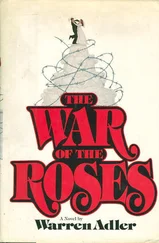Outside I meet Olha who works for the public administration. She lives in the building next to the school. What does she think about all of this? She was exhilarated when she saw the Ukrainian army in the city.
“I was shouting ‘hurrah!’” she says.
A man passing by listens to her and comments: “Madam, you were bombed so nicely.”
Very often it is the Ukrainian army that is accused of the destruction. However Olha doesn’t agree.
“Look, what ‘ours’ have done,” she says sarcastically about the separatists. “For such ‘ours’ thanks a lot.”
Although the Kramatorsk city center is seriously destroyed, its residents don’t suffer as much tragedy as those in Slovyansk. Water shortages are the only problem, but a few water tanks nearby are enough for basic needs. Electricity is everywhere. No one is staggering due to dehydration or hunger. Almost everything is available in the shops. When I open a freezer, it is full of seafood. It is hard to believe that Slovyansk and Kramatorsk are separated by little more than ten kilometers.
IN JULY 2014 Donetsk is still a relatively peaceful place, but here is where you can best see the changes that have taken place during the conflict. From a typical European city, it has turned into a godforsaken hole.
What stands out at first sight is the emptiness. You can see with your naked eye that, unlike in April or even May, there are fewer people. Traffic in the streets has almost vanished. Traffic jams in Donetsk? No one remembers they ever existed. Some residents took their cars away from the city, others hid them securely.
“They are concealing the cars, because the separatists steal them. It’s simple: if they like a particular vehicle, they take it. All those pricey SUVs were not theirs,” says Pavlo, a cabbie, who drives me around Donetsk. “I don’t even wear my watch because I don’t want to lose it.” He shows me a bare wrist.
One day I’m sitting in one of the few bars that are open until late at night and a Porsche Cayenne pulls over. Two uniformed young men get out. Theoretically, at ten o’clock curfew begins, but it is the insurgents who break it most often. As it turns out, these two are from Russian Ryazan. They have come for a double date. Their girlfriends are already here. Laughing, conversations, flirtations. A car pulls over outside and one of the militants gets up from the table. He pulls two huge bunches of roses out of the car. One is white, the other red. He hands them over to the women sitting at the table. When a few shots are heard nearby, their security guards show up. The “Donbas volunteers,” with rifles, line up in front of the bar. They obediently wait until the rendezvous is over.
It is not only expensive SUVs that fall prey to the separatists. It can be any car or even an ambulance. One day when I was walking down Ilyich Avenue, I was passed by a black car that looked like a delivery vehicle. Inside I noticed a man in uniform. Only when the car drove away did I recognize the lettering AMBULANCE. Probably out of haste or laziness no one had removed the lettering. Rumors spread fast among Donetsk residents that ambulances were to be avoided because you could find a “surprise.” Not all the seized ambulances were repainted.
Empty spaces are particularly visible in places that in April and May were teeming with life, on Pushkin Boulevard, for example. Two months ago it was full of people walking, relaxing, and socializing. Now it is as gloomy as the rest of the city. It’s not a problem to find a seat on a bench because they are almost all empty. It’s more difficult to make a dinner reservation because the restaurants are closing one by one. When I arrived in Donetsk on July 11 there were still many. When I left the city ten days later only half of them were still functioning or they closed very early.
Although many stores have shut down, shopping for food is not difficult. All basic products are available, but the selection is more limited. And there are problems with ATM machines. Some of them have notices posted: “No money.” Similarly, banks are often closed for “technical reasons.” You can’t miss the open ones because they are full of people. Functioning ATM machines have daily limits, getting lower and lower every day. I did manage to find five machines that still dispensed money. They will soon stop working, too. Coming to the city with cash withdrawn somewhere else is the best option.
After a thirty-minute tram ride and a short walk I reached the apartment building where I was renting a flat.
“I have been left alone here. I don’t know what for. Perhaps I should leave, too?” says Raya, my landlady. At the stairwell entrance there is a posted notice. I learn that in case of artillery shelling there is a bomb shelter in a nearby basement. A few days later a new notice appears saying that cold water will only be available from five to ten in the morning and from five to ten at night. Hot water can only be had in the evening. I can’t complain because I live in the city center and the water problem is less bothersome here than on the outskirts. There the water pressure is very low and hot water almost doesn’t exist. Responding to “numerous questions from the residents,” the City Council put out an announcement explaining that water in the fountains is recycled through a closed recirculating system. People had probably been outraged by the presumed wastefulness.
Why hasn’t Pavlo, the cabbie, left yet? Like many other people he has no place to go, but he is afraid to stake everything on one roll of the dice.
“I don’t have any family to take me in permanently. I have no idea how I could start a new life with my wife and two children but without any support,” he explains. It happens very often to Donbas residents that the Donetsk or Luhansk regions, or the city in which they were born, is their entire world. They have never left its borders. That’s why now, even if their life is in danger, they are scared to risk everything, and they try to wait for the war to end. Others simply have to stay here. They can’t afford to live anywhere else.
Pavlo claims that people are tired of the separatists, but usually they are not eager to organize and challenge the new “authorities.” And when they are eager, they don’t know how.
But first impressions are completely different. Walking in the streets of Donetsk you can easily meet a supporter of the “people’s republic.” These people are very happy to express their views. They are not afraid because what’s to fear? It is their people who control the city. If Ukrainian forces enter Donetsk, the Slovyansk scenario may be repeated: some people will flee and others will transform themselves from separatists into Ukrainian patriots.
Yet when you come to know the residents better or talk to them far away from the insurgents (many journalists don’t pay attention to this detail when they ask people for their views), you will hear critical remarks about the separatists.
“I am a friend of the Donetsk Republic,” Roman, a translator working for the foreign journalists, says to the separatists. Only when we are alone does he state: “They are scum.”
We Are Developing
The first place in Donetsk any journalist should visit is the office of the Donetsk Public Administration, still the separatists’ headquarters. You can get press accreditation there. It was very early in the morning, so I called them to ask whether I could come.
“Please, come. We are already at work,” replied Klavdia, Press Bureau Secretary of the Donetsk Republic.
The surroundings of the building have been tidied up. The barricades that were here in May are gone, and the only tents still standing are the ones with propaganda materials. The separatists want to prove that the city is totally under their control and that they don’t need any security. I enter the building.
Читать дальше








![Theresa Cheung - The Dream Dictionary from A to Z [Revised edition] - The Ultimate A–Z to Interpret the Secrets of Your Dreams](/books/692092/theresa-cheung-the-dream-dictionary-from-a-to-z-r-thumb.webp)



